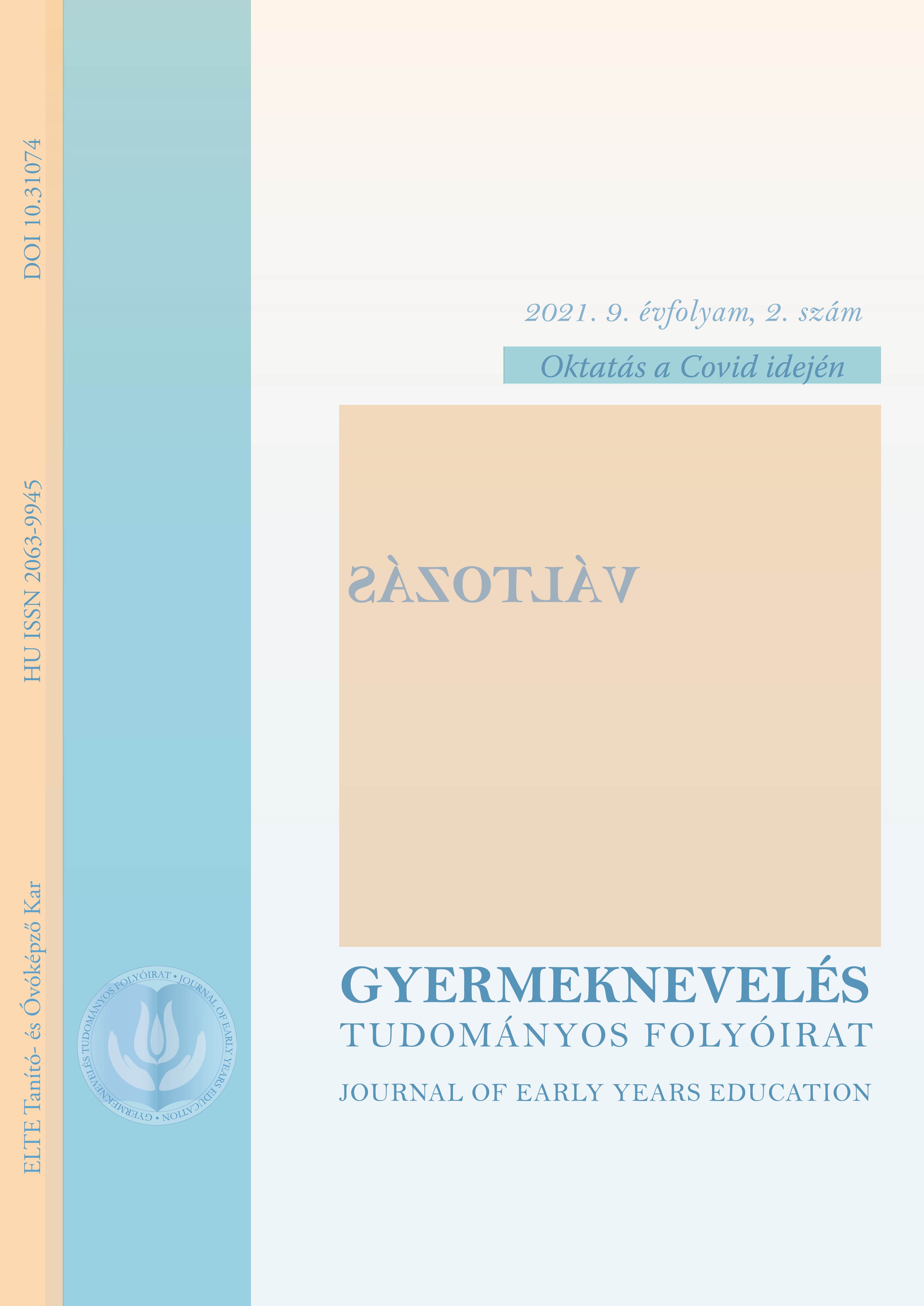The use of technology of children in nursery care
DOI:
https://doi.org/10.31074/gyntf.2021.2.354.377Keywords:
digital technology, children, ICT use, mobil devicesAbstract
The use of technology in early childhood children is a new and controversial area of psychological and educational research, there are no established habits for using these tools and for the consumption of digital contents (Konok, Bunford, & Miklósi, 2020). Parents are not always aware of the dangers and potential risks of technology, while both parents and professionals have need to know and teach appropriate use habits for children (Chaudron et al., 2020). The aim of our research was to get an accurate picture of the digital device use of young children in nursery care and to explore the relationship between different socio-economic factors and children’s use of ICT. In addition, we wanted to explore parents’ opinions on the impact of digital tools on their children, and we also wanted to find out their views on preventive / productive ICT use. For our study, we used a paperbased questionnaire filled out by 234 parents raising children in nursery care. This research shows the main characteristics of the digital technology use of the families with young children and creates an opportunity for professionals to formulate recommendations for a preventive approach to the use of digital technology in early childhood.
Downloads
References
Burroughs, B. (2017). YouTubekids: The appeconomy and mobile parenting. Social media + society, 3(2). https://doi.org/10.1177/2056305117707189
Chaudron, S. (2015). Young Children (0-8) and digital technology: A qualitative exploratory study across seven countries. JRC; ISPRA. https://publications.jrc.ec.europa.eu/repository/handle/JRC93239, https://doi.org/10.2788/00749
Csapóné F. Sz. (2019). Szülők támogatása a kisgyermekek megfelelő médiahasználatában. In Fehér, Á. & Megyeriné, R, A. (Eds.), A digitális világ hatása a gyermekekre – III. Nemzetközi Kisgyermek-nevelési Konferencia kötete. (p. 21). Apor Vilmos Katolikus Főiskola.
Detnakarintra, K., Trairatvorakul, P., Pruksananonda, C. & Chonchaiya, W. (2020). Positive mother-child interactions and parenting styles were associated with lower screen time in early childhood. Acta Paediatrica, 109(4), 817–826. https://doi.org/10.1111/apa.15007
Fehér, Á. & Megyeriné Runyó, A. (2019, Eds). A digitális világ hatása a gyermekekre. III. Nemzetközi Kisgyermek-nevelési Konferencia. Apor Vilmos Katolikus Főiskola.
Fejérváry, K. (2020). Cybergyerekek. Demokrata, 2020.10.16. https://demokrata.hu/tudomany/cybergyerekek-299920/
Gálik, M. & Csordás, T. (2020, Eds.). A média gazdaságtanának kézikönyve. Nemzeti Hírközlési és Média Hatóság, Médiatudományi Intézet.
Google Play Áruház. Digitális jóllét. https://play.google.com/store/apps/details?id=
com.google.android.apps.wellbeing&hl=hu&gl=US
Hódi, Á., Tóth, E., B Németh, M. & Dombi, A. (2019). Óvodások IKT-használata otthon–szülői minta és szerepvállalás. Neveléstudomány, 7(2), 22–41. https://doi.org/10.21549/NTNY.26.2019.2.2
Hsieh, H. C. (2008). Effects of ordinary and adaptive toys on pre-school children with developmental disabilities. Research in Developmental Disabilities, 29(5), 459–466. https://doi.org/10.1016/j.ridd.2007.08.004
Konok, V., Bunford, N. & Miklósi, Á. (2020). Associations between child mobile use and digital parenting style in Hungarian families. Journal of Children and Media, 14(1), 91–109. doi.org/10.1080/17482798.2019.1684332
Koscsóné Kolkopf, J. & Kiss, H. (2020). „Digitális Honfoglalás” avagy 0-3 évesek a digitális világban. Gyermeknevelés Tudományos Folyóirat, 8(2), 202–218. https://doi.org/10.31074/gyntf.2020.2.202.218
Fehérné Kovács, Z., Kas, B. & Pintye, M. (2018). Szempontok a nyelv-és beszédfejlődési zavarok szűréséhez és állapotmegismeréséhez. Családbarát Ország Nonprofit Kft.
KSH (2017): Távközlés, televízió- és internetszolgáltatás – IKT-eszközök és használatuk a háztartásokban, a vállalkozásoknál és a közigazgatásban, 2017. Központi Statisztikai Hivatal. http://www.ksh.hu/docs/hun/xftp/idoszaki/ikt/ikt17.pdf
Lénárd, A. (2015). A digitális kor gyermekei. Gyermeknevelés Tudományos Folyóirat, 3(1), 74–83.
Magyarország Digitális Gyermekvédelmi Stratégiája (2016). Digitális Jólét Nonprofit Kft., https://digitalisjoletprogram.hu/files/86/d8/86d889e8f382b45b80bcca4d5945bbca.pdf?fbclid=IwAR1x4LjGjgo_jUoR7X50QTuW9lRd9HSTq0HcgsIbtMTx8SS6yB6l0JkUqig
Nemzeti Média-és Hírközlési Hatóság (2018). A három éven aluli gyermekek médiahasználati szokásai. http://nmhh.hu/dokumentum/195599/3_even_aluliak_mediahasznalata.pdf
Németh, I. P., Bacsa-Bán, A., Rajcsányi-Molnár, M. (2020, Eds.): Civil Szemle – Különszám. Oktatás, digitalizáció, civil társadalom. Civil Szemle Alapítvány, .
Orlowski, J. (2019, rendező). Társadalmi dilemma (film). Netflix Inc., Los Gatos.
Rausch, A. & Pásztor, A. (2021). Mobil eszközök az óvodában: A digitális technológiával támogatott értékelés és fejlesztés lehetőségei. Neveléstudomány, 9(3), 5–17. https://www.doi.org/10.21549/NTNY.33.2021.2.1
Steyer, J. P. (2012). Szólj vissza a facebooknak! Gyakorlati útmutató a gyerekneveléshez a digitális korszakban. GABO Kiadó Kft.
Stienwandt, S., Cameron, E. E., Soderstrom, M., Casar, M. J., Le, C. & Roos, L. E. (2020). Keeping Kids Busy: Family Factors Associated with Hands-on Play and Screen Time During the COVID-19 Pandemic. https://doi.org/10.31234/osf.io/prtyf
Tsouklidis, N., Tallaj, N., Tallaj, Y. & Heindl, S. E. (2020). Lights Out! The Body Needs Sleep: Electronic Devices and Sleep Deficiency. Cureus, 12(7). https://www.doi.org/10.7759/cureus.9292
Visnjic-Jevtic, A., Varga Nagy, A., Ozturk, G., Şahin-Sak, İkbal T., Paz-Albo, J., Toran, M. & Sánchez-Pérez, N. (2021). Policies and practices of early childhood education and care during the COVID-19 pandemic: Perspectives from five countries. Journal of Childhood, Education & Society, 2(2), 200–216.
Downloads
Published
How to Cite
Issue
Section
License
Copyright (c) 2021 Author

This work is licensed under a Creative Commons Attribution-NonCommercial-ShareAlike 4.0 International License.

